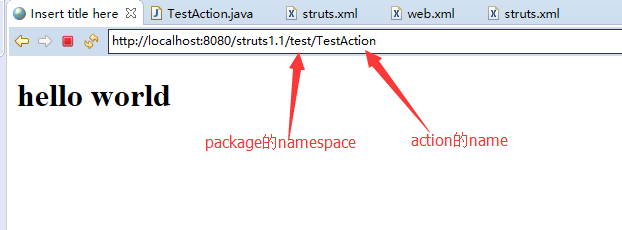layout: post
title: Struts2
subtitle: Struts基础
date: 2018-05-28
author: ZL
header-img: img/20180528.jpg
catalog: true
tags:
- Struts
搭建运行实例
- 导包
- 书写Action类
package zl.hello;
public class TestAction {
public String test() {
// TODO Auto-generated method stub
System.out.println("1111111111111111111");
return "success";
}
}
- 书写src/struts.xml配置文件
/hello.jsp
- web.xml
struts2
org.apache.struts2.dispatcher.ng.filter.StrutsPrepareAndExecuteFilter
struts2
/*
- 运行
配置文件详解
struts.xml配置
- package:将Action配置封装.就是可以在Package中配置很多action.
- package的name:package的名字,不能与其他package name重复。
- package的namespace:给action的访问路径中定义一个命名空间。就是在浏览器里面输入的地址。
- package的extends:继承一个指定包。
- package的abstract(一般用不到):包是否为抽象的,标识性属性,标识该包不能独立运行,专门用来被继承。
- action的name:浏览器中的地址名称。
- action的class:Action的全类名。
- action的method:Action类的方法名称。指定调用Action的哪个方法来处理请求。
- result的name:action中方法的返回值。标签体的内容是页面的路径。
- result的type:指定调用哪个result类来处理结果。默认type="dispatcher"。
result的type有下面几种。
struts2常量配置
不去配置的话,有默认的配置。
修改常量配置。(一般就使用第一种)
- 方式一:
在src/struts.xml中:
- 方式二:
在src下创建struts.properties
- 方式三:
在项目的web.xml中
加载顺序(后加载的配置覆盖先加载的配置)
常量有哪些?
进阶配置
动态方法调用
问题引入
还是上面的例子,现在TestAction里面有多个方法。
package zl.hello;
public class TestAction {
public String fun1() {
System.out.println("fun1");
return "success";
}
public String fun2() {
System.out.println("fun2");
return "success";
}
public String fun3() {
System.out.println("fun3");
return "success";
}
}
可是一个package只能配置一个method。想要调用三个方法,还得配置三个package。
/hello.jsp
/hello.jsp
/hello.jsp
这就比较麻烦了,动态方法调用就可以解决这个问题,一个package就可以访问到Action里面的多个方法。
方式一(不常用)
strutsx.xml配置文件。
/hello.jsp
使用:
调用fun1
http://localhost:8080/struts1.1/test/TestAction!fun1
调用fun2
http://localhost:8080/struts1.1/test/TestAction!fun2
调用fun3
http://localhost:8080/struts1.1/test/TestAction!fun3
方式二
strutsx.xml配置文件.注意action的name和method。
/hello.jsp
使用:
调用fun1
http://localhost:8080/struts1.1/test/TestAction_fun1
调用fun2
http://localhost:8080/struts1.1/test/TestAction_fun2
调用fun3
http://localhost:8080/struts1.1/test/TestAction_fun3
include引入xml
与Android的xml里面的include引入功能一样。
Action类的创建方式。(方式三最常用)
方式一
//方式1: 创建一个类.可以是POJO
//POJO:不用继承任何父类.也不需要实现任何接口.
//使struts2框架的代码侵入性更低.
public class Demo3Action {
}
方式二
//方式2: 实现一个接口Action
// 里面有execute方法,提供action方法的规范.
// Action接口预置了一些字符串.可以在返回结果时使用.为了方便
//Action.SUCCESS;
//Action.ERROR;
//Action.NONE;
//Action.INPUT;
//Action.LOGIN
import com.opensymphony.xwork2.Action;
public class Demo4Action implements Action {
@Override
public String execute() throws Exception {
return Action.SUCCESS;
}
}
方式三
//方式3: 继承一个类.ActionSupport
// 帮我们实现了 Validateable, ValidationAware, TextProvider, LocaleProvider .
//如果我们需要用到这些接口的实现时,不需要自己来实现了.
import com.opensymphony.xwork2.ActionSupport;
public class Demo5Action extends ActionSupport{
}
result的type的四种类型
type有很多种类型,这里介绍四个,他们是dispatcher、redirect、chain、redirectAction。
/hello.jsp
/hello.jsp
Demo1Action
/
Demo1Action
/









